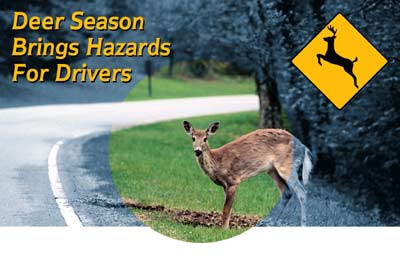Deer Season Brings Hazards For Drivers

As we enter December, we enter the peak season for deer/auto collisions–a time when deer-related auto insurance claims average $2,000.Each year in the United States there are approximately 500,000 reported accidents involving deer according to the Insurance Information Institute (III). Such collisions result in hundreds of deaths, thousands of injuries and countless amounts of property damage. Deer/auto collisions add to the more than 40,000 comprehensive claims filed each year at Alfa Insurance Co.To help save lives–and reduce claims–Alfa agents throughout Alabama are warning their customers to keep their eyes open when traveling during deer season.Nearly two-thirds of reported accidents occur October through January, when deer are more active due to mating season and highways are busier due to holiday travel. But Alfa agents say knowing a few facts about past deer/auto collisions can protect drivers from pain, injury and money loss, as well as save the lives of some 350,000 deer that die annually from such accidents.In 1982, the University of Alabama Crash Analysis Reporting Environment (CARE) system was founded and has been categorizing vehicle accidents since 1993. Dr. David Brown, director of the computing and information division of the center, monitors the number of accidents each year and the variables surrounding them, including animal related crashes.”We don’t have deer broken out in our figures of accidents,” Brown said. “But, we recognize that probably 90 percent or more of the crashes involving animals would be deer, and the times of day and place of the accidents are conclusive.”Research by CARE and the III show that deer/auto collisions often happen during morning and evening hours, when people and deer are most on the move. Last year, 2,764 animal-related accidents occurred in Alabama. Of these, 334 collisions were between 5 a.m. and 7 a.m., and a surprising 1,014 collisions were between 5 p.m. and 9 p.m. Keith Guyse of the Alabama Game and Fish Division attributes these high numbers to the periods being major commute times.”During the morning or evening, people are either going to or coming from work,” Guyse said. “Oddly enough that’s when deer travel as well. Combine the two, and you’re going to have accidents.”Adding to the problem is the increasing national deer population, which has more than doubled in the past 20 years, from 10 million to 27 million. In Georgia, the whitetail deer population stands at 1.1 million, Alabama’s is at 1.6 million and Mississippi’s is at 1.75 million. “More deer don’t help, especially with more people moving to rural areas,” Guyse said. “October is when the population hits its peak here, when all the fawns are born. You’ll usually see more accidents starting then.”In January and February Alfa surveyed its animal collision claims for a 13-day period. The survey revealed that 391 deer/auto claims were paid and closed in Alabama and 20 each occurred in Mississippi and Georgia just during those 13 days.”We usually do not track deer/auto collisions,” said Joe Cotney, Alfa regional claims manager for south Alabama. “But my impression is that they do happen quite often and the numbers support it.”To help drivers avoid deer auto collisions, Alfa agents are reminding their customers that most deer/auto collisions occur at night on rural, two-lane county roads at speeds of 51-55 mph, and most drivers can see the deer 8 to 20 feet before they hit it. According to the III, most fatalities and injuries occur when people swerve to miss the deer and collide with an oncoming car or roadside object.Drivers also are encouraged to follow these safety precautions and tips:Be aware and vigilant in morning and evening hours, the most active times for deer movement.Use your high-beam headlights when you can. The lights reflect in the deer’s eyes and allow you to see the deer better. If you spot a deer, slow down and blow your horn with one long blast to frighten the deer away.Brake firmly when you see a deer in your path. Do not swerve, it can confuse the deer and cause you to lose control of your vehicle. Always be alert when passing through a deer-crossing zone, these areas are designated because of their history as frequent spots for deer activity or accidents.Always wear your seatbelt. Most people injured in deer/auto crashes weren’t wearing a seatbelt.If you see one deer, look for others. They seldom travel alone.If you hit a deer, do not touch the animal. Get your car off the road and call the police.Contact your Alfa Insurance agent to report the damage to your car.
Tiffany Trueblood is a marketing communications specialist with Alfa Mutual Insurance Co.
